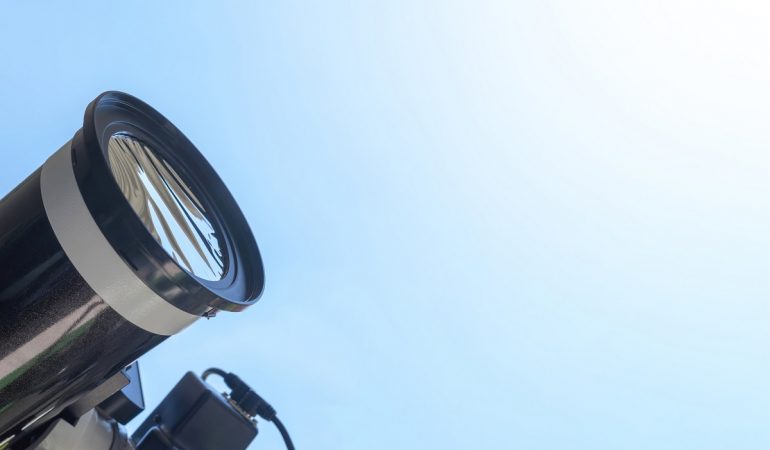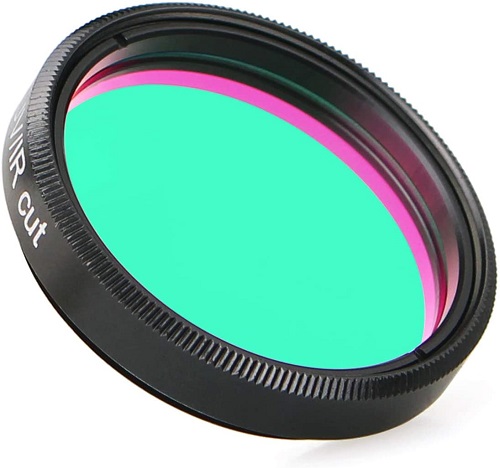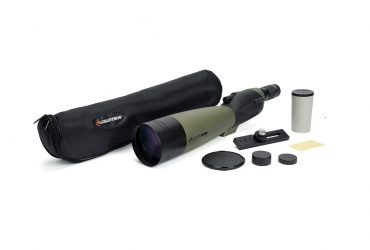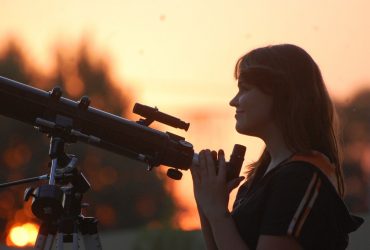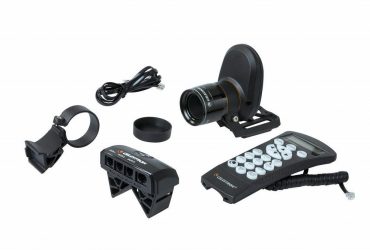How To Choose The Best Telescope Filters?
A telescope and at least two (one high-power and one low-power) eyepieces are enough to get you started in amateur astronomy. You can enhance and expand your observations further using accessories. There are plenty of telescope accessories to choose from including Barlow lenses, star diagonal and a camera adapter among others. The accessories you’ll find most useful are telescope filters.
A telescope filter will not increase the magnification or field of view of your telescope. But, it can make it easier to observe or photograph different celestial objects by filtering out and letting in certain light wavelengths.
Depending on the filter you are using, this can reduce glare when observing the moon and bright stars or keep out light pollution from streetlights.
Before you spend a lot of money buying additional eyepieces and other accessories, consider buying at least two telescope filters. It’ll make a big improvement in your viewing experience.
To start with, get a moon filter and a solar filter. If you do most of your observations in an urban area, get a light pollution filter as well. If you dabble in astrophotography, you may also want a UV/IR filter.
In this buying guide, I recommend the best telescope filters on the UK market, and give you tips for choosing the right filter for your telescope.
Key Considerations When Choosing a Telescope Filter
A. Type of Filter
This is the most important consideration when buying a telescope filter. The best type of filter depends on which objects you observe most as well as your environment.
Here are the different types of filter and their uses.
- Light pollution filter: A light pollution filter blocks light from manmade sources such as streetlights. This darkens the night sky and makes objects like nebulae stand out for easier viewing. A light pollution filter also allows you to take clearer photos of the night sky.
- Moon filter: Moon filters are neutral density (ND) filters that reduce the amount of light reaching your eye. They reduce glare from bright night sky objects such as the moon, planets and very bright stars. A moon filter makes it easier to observe objects that appear too bright through your telescope eyepiece.
- Colour filters: Colour filters allow you to observe specific planets in more detail. There are different types of colour filters including red, blue, green and yellow. Different colour filters bring out specific details of a planet. For example, red is great for seeing the dusty plains on mars while a deep yellow is best for observing the polar caps.
- Narrowband and line filters: These filters are helpful when observing deep space objects. Narrowband filters block all light except specific wavelengths associated with certain nebulae. Line filters such as Oxygen III filters are even more specific. They allow only one or two wavelengths through.
- Solar filters: Using a telescope to look at the sun can cause permanent damage to your eyes and telescope. To safely observe the sun, you’ll need a solar or sun filter. A solar filter blocks most of the light from the sun, making it safe to view it through your telescope. Unlike other filters that attach to the eyepiece, a solar filter is attached over the aperture so that it protects the entire telescope as well as your eyes.
B. Type of Housing
We recommend buying a telescope filter with a metal housing rather than a plastic one. A filter with metal housing is more durable and fits better over the eyepiece’s threading.
C. Size
Make sure the filters you buy match the size of your telescope and eyepiece. Most filters come in 1.25” and 2” sizes. If you have a 1.25” diagonal and eyepiece, get a 1.25” filter.
If you are buying a solar filter, check the size requirements for the outer telescope tube. Most solar filters are designed to fit a range of tube sizes.
Another size aspect to check is your telescope’s aperture. Because telescope filters work by filtering out some of the light, you need a telescope with a relatively large aperture to ensure you can still see objects in the sky.
Putting a filter on a telescope with a small aperture may darken images to the point where you cannot make out most details.
Most manufacturers recommend using their filters on telescope with a minimum 6” aperture. If you plan to stack two filters on the eyepiece (a common technique when using colour filters), you’ll need a telescope with an aperture of at least 8”. That’s because two filters block more light, thus you need a telescope that lets in plenty of light.
Best Telescope Filters: Reviews
1. Meade Series 4000 Moon Filter ND96

Amateur astronomers will find this Meade moon filter handy for observing the moon and bright planets in the solar system. This neutral density filter reduces light transmission to a level more comfortable for your eye.
This reduces glare when observing the moon and planets and highlights details you may have otherwise missed.
The Meade Series moon filter reduces brightness uniformly across all wavelengths, so it doesn’t affect the colour of the moon and other objects.
In addition to solar system sightings, you can use the Meade neutral density filter to observe double stars where one star is significantly brighter than the other. By using the Meade filter, you can reduce glare from the brighter star, allowing you to observe both stars.
The Meade Series moon filter fits onto 1.25” eyepieces. Simply screw it to the bottom of your eyepiece barrel and then attach your eyepiece into your telescope focuser or diagonal as you normally would.
What we like about it:
- High quality and durable metal housing.
- Makes moon and planetary observations easier and more comfortable.
- Compatible with most telescopes and eyepieces.
2. Explore Scientific Sun Catcher Sun Filter

If you want to look at the sun, we recommend the Sun Catcher sun filter from Explore Scientific.
This filter is available in multiple sizes, but the one that will fit most amateur telescopes is the 80-102mm size. This size fits telescopes with an outer tube diameter within this range.
To be sure, measure your telescopes outer tube or check the manual for size specifications. You can then choose the right sized Sun Catcher filter.
The Sun Catcher filter comes with foam inserts that you cut to size to get the filter to fit snugly on your telescope’s outer tube.
The filter itself consists of a Thousand Oaks Solarlite film. The film is approved for unlimited direct sun observations.
Once you fit the sun filter over your telescope, you can safely observe the sun. You can see the red spots and other features clearly.
The Explore Scientific sun filter is also great for solar photography, especially during eclipses.
What we like about it:
- Ensures safe solar observations and photography.
- Fits a wide range of telescope tube sizes.
- Includes foam inserts for a perfect fit.
3. Celestron 94119-A 1.25 Inch Moon Filter

If you are looking for a budget moon filter, we recommend the Celestron 94119-A. The reason it is cheaper than the Meade Series moon filter is that it has a plastic housing.
The biggest concern with plastic telescope filters is not that they’ll fall and break. Rather, it is the quality of the threading.
With repeated use, the plastic threading may deteriorate to the point where you cannot securely attach the filter to the eyepiece. So don’t expect the Celestron moon filter to last as long as the Meade filter. But if you only need it for occasional moon observations, it’ll last long.
The Celestron 94119-A moon filter threads onto 1.25” eyepieces and reduces glare from the moon for easier viewing. You can also use it to view bright planets in the night sky.
What we like about it:
- Reduces glare from moon and planets.
- Also ideal for terrestrial viewing.
- Easy to fit onto standard size eyepieces.
4. Svbony 1.25″ Infra UV/IR Filter
CMOS and CCD sensors used in most digital cameras capture ultra violet and infrared wavelengths in addition to visible light wavelengths. This results in reduced image quality.
The Svbony UV/IR filter stops transmission of both UV and IR radiation, only allowing through visible light to reach the camera attached to the telescope. This makes for vivid images with more detail and clarity. The low-reflection multilayer coating on the lens ensures images remain bright.
If you do a lot of astrophotography, the Svbony UV/IR filter is a great addition to your kit. It is compatible with all 1.25” eyepieces.
What we like about it:
- Reduces atmospheric haze when taking photos.
- Improves image sharpness and clarity.
- Compatible with standard size eyepieces.
5. Baader Planetarium AstroSolar Solar Filter

The Baader Planetarium AstroSolar sun filter is a cheaper alternative to the Explore Scientific sun filter. However, it requires some DIYing to use it with your telescope.
Unlike the Explore Scientific sun filter, the AstroSolar filter doesn’t come with any kind of housing. It’s just a sheet of solar film that blocks over 99% of sunlight.
You’ll need to make your own housing using cardboard and tape. The instructions and cutting template included with the filter should help.
The film measures 140 x 155mm, so it should fit over most hobbyist telescopes.
Note: One big difference between the Baader and Explore Scientific solar filters is the appearance of the sun. The Explore Scientific filter produces a yellow sun while the sun appears white when viewed through the Baader filter. With either filter, it’s easy to pick out sunspots and other features on the surface of the sun.
What we like about it:
- Fits most telescopes.
- Low cost.
- Great for solar observations, solar eclipses and solar photography.
